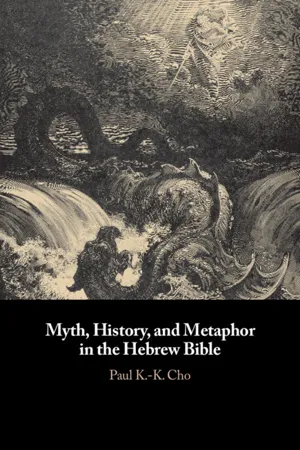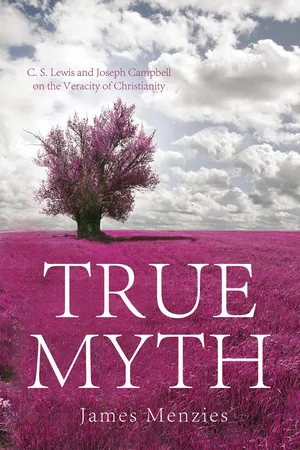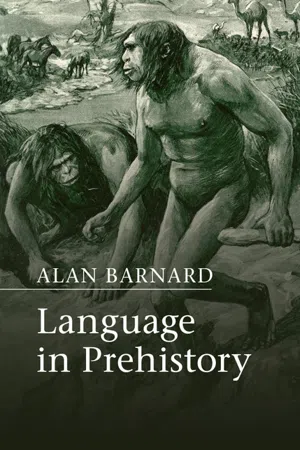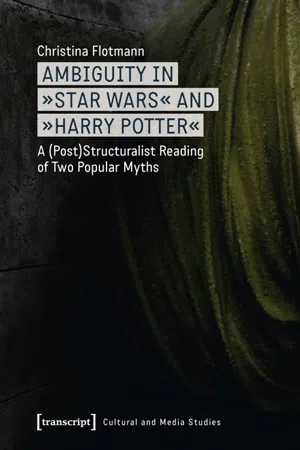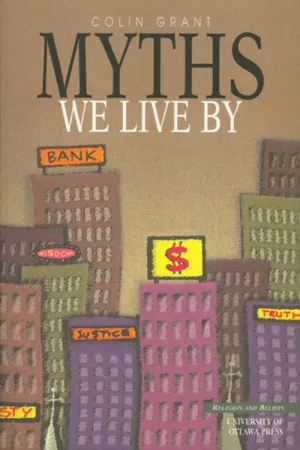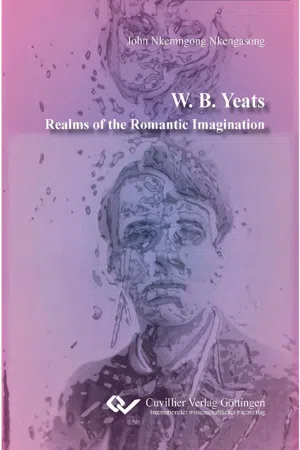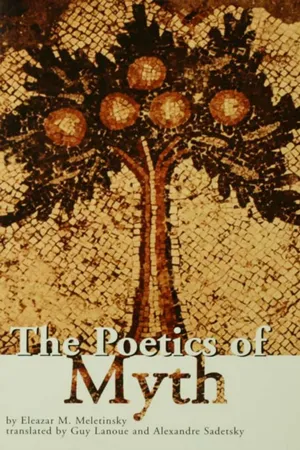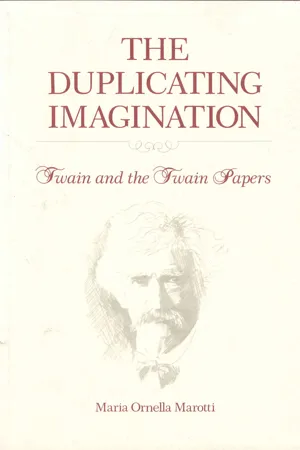Literature
Myth
A myth is a traditional story that typically explains the origins of a culture, natural phenomena, or religious beliefs. It often features gods, heroes, and supernatural beings, and is passed down orally or through written literature. Myths serve to convey cultural values, beliefs, and customs, and are an important part of literary traditions worldwide.
Written by Perlego with AI-assistance
Related key terms
1 of 5
11 Key excerpts on "Myth"
- eBook - PDF
Reality and Truth in Literature
From Ancient to Modern European Literary and Critical Discourse
- Irena Avsenik Nabergoj(Author)
- 2013(Publication Date)
- V&R Unipress(Publisher)
(Cuddon 1998: 526) Chris Baldick’s 2004 Concise Oxford Dictionary of Literary Terms refers to the multiple meanings of Myth: Myth, a kind of story or rudimentary narrative sequence, normally traditional and anonymous, through which a given culture ratifies its social customs or accounts for the origins of human and natural phenomena, usually in supernatural or boldly imaginative terms. The term has a wide range of meanings, which can be divided roughly into “rationalist” and “romantic” versions: in the first, a Myth is a false or unreliable story or belief (adjective: Mythical), while in the second, “Myth” is a su- perior intuitive mode of cosmic understanding (adjective: Mythic). In most literary contexts, the second kind of usage prevails, and Myths are regarded as fictional stories containing deeper truths, expressing collective attitudes to fundamental matters of life, death, divinity, and existence (sometimes deemed to be “universal”). Myths are usually distinguished from legends in that they have less of an historical basis, although they seem to have a similar mode of existence in oral transmission, re-telling, literary adaptation, and allusion. (Baldick 2004: 163 – 164) The phenomenon of Myth in all its forms of course essentially influences the relation between history and literature. The viewpoints of reality in history writing and in literature are, as mentioned, defined by Aristotle at the beginning of Chapter 9 of Poetics: It is not the function of the poet to relate what has happened, but what may happen – what is possible according to the law of probability or necessity. The poet and the historian differ not by writing in verse or in prose. The work of Herodotus might be put into verse, and it would still be a species of history, with meter no less than without it. The true difference is that one relates what has happened, the other what may happen. - Paul K.-K. Cho(Author)
- 2019(Publication Date)
- Cambridge University Press(Publisher)
2 Myth as Story and Metaphor The task of defining Myth is fraught with pitfalls. Even a preliminary survey of the literature reveals that Myth is a contested term and suffers from a proliferation of definitions and uses. 1 For example, noting that “[t]here is no study of Myth as Myth,” only studies of Myth as a subset within a larger disciplinary domain, Robert A. Segal states that “[e]ach discipline harbours multiple theories of Myth.” 2 In other words, the study of Myth occurs under the aegis of a multiplicity of disciplines, and each discipline multiplies definitions and theories of Myth. No surprise, then, that no single definition of Myth has or is likely to win the assent of all its students. Every definition of Myth, which is inevitably an interpretative abstraction from a select set of data, is vulnerable to criticism from some corner that it includes or excludes contested material. Yet, it is important to venture a definition because, inevitably, different definitions have an affinity with different methods and theories that have a direct bearing on the interpretation of concrete Myths. Thus, I offer the following definition as a practical way forward, while fully acknowledg- ing its limitations: Myth is a story about weighty matters involving deities, 1 For general surveys of theories of Myth, see Percy S. Cohen, “Theories of Myth,” Man 4 (1969): 337–53; Oden, Bible without Theology, 57–90; Robert A. Segal, Myth: A Very Short Introduction (Oxford: Oxford University Press, 2004). For a survey of the study of Myth in biblical studies, see John W. Rogerson, Myth in Old Testament Interpretation (BZAW 134; Berlin: de Gruyter, 1974). 2 Segal, Myth, 2. 11 human beings, and other personalities that, in the understanding of its adherents, reveals something true about the real order of the world. 3 I would like to underline two focal points of the definition critical to the following discussion.- Susan Sellers(Author)
- 2017(Publication Date)
- Bloomsbury Academic(Publisher)
1 1 Contexts Theories of Myth What is Myth? Dictionaries are always a useful place to start, even if only to provide a jumping-off point for disagreement and quibble. The Oxford English Dictionary gives a surprisingly short definition of the word ‘Myth’. It states it is ‘a purely fictitious narrative usually involving supernatural persons, actions, or events, and embodying some popular idea con-cerning natural or historical phenomena’. It points out that as a con-sequence it can mean ‘a fictitious or imaginary person or object’, and that there is the subsidiary meaning in standard usage of ‘an untrue or popular tale, a rumour’. In this instance, the dictionary definition does not advance us very far, since its insistence on the ‘purely ficti-tious’ appears to override the complex interactions between life and story that seem the generating force of Myth even while its inclusion of the ‘popular’ returns it to the common domain. Perhaps Mythogra-phers will provide us with more fruitful descriptions. A Myth, writes Lewis Spence in what appears to be an expanded gloss of the OED , is the account of the deeds of a god or supernatural being, often devised in order to explain our relation to the universe, the environment or a social programme. 1 Michael Bell, hedging his bets on the dictionary options, defines it as ‘both a supremely signifi-cant foundational story and a falsehood’. 2 For Eric Dardell, Myth is a ‘typical’ story with immediate and exemplary impact, whereas for Riane Eisler it concerns ‘larger-than-life’ people and events that are passed down from generation to generation. 3 R. G. Stone stresses Myth’s moral dimension, whereas what is important for John J. White is the fact that Myth is so continually repeated that it gradually creates its own resonant force. 4 For Sigmund Freud Myth is the projection of psychology onto the external world; for Jean-François Lyotard it is a form of fantasy; for Albert Cook it is a ‘technique for handling the unknown’.- eBook - ePub
True Myth
C. S. Lewis and Joseph Campbell on the Veracity of Christianity
- Menzies(Author)
- 2014(Publication Date)
- Pickwick Publications(Publisher)
2Myth, An Attempt to Define the Indefinable
M yth, fantasy, and allegory are terms that identify a genre familiar to many in the reading public. More difficult to understand is how these terms have been defined. In what ways are they similar and in what ways are they unique? In the context of this study, it is necessary to ask what bearing, if any, these concepts have on religious faith.To further understand these ideas and their relevance in a technological society, it is important to explore the meaning of Myth and its influence upon religion. To accomplish this purpose the idea of Myth as a religious phenomenon will be considered, then Myth as a cultural phenomenon, and finally Myth as a literary genre.The Challenge of a DefinitionIn commenting on the challenges of defining and explaining Myth, J. R. R. Tolkien astutely observes that “Mythology is not a disease at all, though it may like all human things become diseased.”59 This observation serves as a caution to anyone claiming to have the last word regarding a definition of Myth. A review of the literature reveals that no single definition of Myth satisfies those who study the topic, and yet how one defines Myth determines what one reads or writes on it. Robert Segal, who has spent a lifetime teaching on Myth, comments, “I have attended many a conference at which speakers fervently propound on ‘the nature of Myth’ in novel X or play Y or film Z. Yet so much of the argument depends on the definition of Myth.”60 Segal follows this remark with his own succinct definition: “I will instead define Myth as simply a story about something significant . . . the story can take place in the past . . . or in the present or the future.”61In a personal correspondence to his friend Owen Barfield, C. S. Lewis shared the state of affairs concerning the word among academics in the latter half of the 1920 - eBook - PDF
- Alan Barnard(Author)
- 2016(Publication Date)
- Cambridge University Press(Publisher)
‘Myth’, with the exact meaning we generally give it, is not a concept found everywhere. Yet Myth-like structures, with metaphor, allusion to deities, semi-deities and heroes, unusual deeds that take meaning from opposition to other deeds, and so on, are found on all continents. This universality of the genre is important. Myths and other narratives are passed down from gen- eration to generation, along with great amounts of accumulated knowledge acquired, of course, by individuals within their respective societies. Together, both narratives and practical skills constitute what makes us human. This may be less true for humans living in the last 10,000 years or so in the Middle East or Europe, but it is certainly true of Homo sapiens sapiens over the major- ity of its 200,000 year existence. With narrative comes the ability to create, and to understand through speech, hearing and learning, the symbolic world. Symbolism is crucially important in the development, if not the absolute ori- gin, of language. It is the symbolic world, understood through language, that has enabled humans to build up the classification systems through which we understand what lies beyond language. These systems, in turn, regulate vocabu- laries, grammars and the means of communicating them to and with others. These others thereby acquire both linguistic competence and some practical use to make of it. And through this, we collectively have acquired our skills at manipulating the many hundreds and ultimately thousands of words that enable us to classify things. Lévi-Strauss (1963: 213–18) argued that Myth is crucial to classification. Myth entails the ability to manipulate characters (real or fictitious) in space and time. Through such manipulation, tales emerge and intermingle in a truly human universal of creative activity. The fact that such creative activity is not readily apparent is simply that it has not been a focal point of empirical - eBook - PDF
Ambiguity in »Star Wars« and »Harry Potter«
A (Post)Structuralist Reading of Two Popular Myths
- Christina Flotmann(Author)
- 2014(Publication Date)
- transcript Verlag(Publisher)
1 Bolle, for instance, defines Myth as “(...) a story concerning gods and superhuman beings.” Furthermore, he says, “[a] Myth is an expression of the sacred in words: it reports realities and events from the origin of the world that remain valid for the basis and purpose of all there is” (261). 26 | A MBIGUITY IN S TAR W ARS AND H ARRY P OTTER Karen Armstrong starts her Short History of Myth with five important points about the workings and functions of Myth within human society. The first one is that Myth “is nearly always rooted in the experience of death and the fear of extinction.” 2 As second point she mentions that it “is usually inseparable from ritual.” 3 Thirdly, according to her, “Myths are about extremity; they force us to go beyond our experience.” 4 Armstrong goes on to say that a “Myth is not a story told for its own sake. It shows us how we should behave.” 5 “Finally,” she holds that “all Mythology speaks of another plane that exists alongside our own world, and that in some sense supports it.” 6 Her five-point summary provides a general idea of what Myth is about, although her points overlap in some instances. Her first and fifth claim, for instance, go together. Fear, especially of death and the seeming pointlessness of earthly existence, motivates people to invent stories that give their lives meaning and lift them up to a transcendent plane on which after death they continue to exist in the presence of some deity. Armstrong’s first point then is the cause for people’s propensity to tell stories while her fifth one refers to the outcome of the human fear of death. Armstrong is not alone in attributing an escapist, fear-alleviating function to Myth. Elemér Hankiss in his work Fears and Symbols perceives existential fears to be at the heart of human civilisation. - eBook - PDF
- Sophia Heller(Author)
- 2012(Publication Date)
- SUNY Press(Publisher)
Thus, what sustains the Myth is the telling and retelling of one’s stories, fantasies and dreams, without worry for exact beginnings, middles, or endings. Insofar as Myth is a fiction to be kept alive, and a purposeful fiction at that, this speaks to the sensibility behind Myth that seeks meaning and depth—the poetry of life—above anything else. But the loophole that repeatedly surfaces is that, despite the freedom and willingness to work within modern conceptions of Myth, the desire for a ficti- tious Myth to satisfy the quest for meaning and restore soul to the world betrays the belief or secret hope that whatever lingers of Myth today has some correspondence with archaic Myth, where, it bears restating, meaning and soul were never perceived as missing. To the degree that Myth and meaning are synonymous as they are eternal, any search for meaning by default will lead one to Myth. “What is Myth but the meanings that structure our lives? What is Myth but the story that takes each individual moment of a life and places it in a context, a plot, a cohesive movement? [. . .] That’s what ‘meaning’ is. Meaning is Mythological. Myth is meaning” The Personalization of Myth 73 (Bond 57). However, to insist on our stories as Myths not only belies their imagined inadequacy but also reveals one prime clue indicat- ing that this is a psychological and not a Mythological matter, and that is need. Bond states it succinctly: “The need for Myth is the need for meaning” (25). No doubt, he would agree that such a need points to a psychological lack and suffering. But a persistent need that must be fulfilled by something commonly understood to be gone speaks only to the irrevocableness of the loss and the subse- quent failure of looking to Myth for meaning. - eBook - PDF
- Colin Grant(Author)
- 1998(Publication Date)
- University of Ottawa Press(Publisher)
In anthropology, classics, folklore, philosophy, and religious studies departments, Myth is often the sub-ject of study and research. Perhaps its most prominent association in the scholarly sense is with classics courses. The Myths of ancient Greece and Rome are standard academic fare, alongside the culture, history, architecture, and archaeology of those civilizations to which we are heir. Mythology courses in classics departments identify the gods and goddesses of ancient Greece and Rome, and recount their exploits among themselves and in the world of mortals. So intertwined are these elements that the line between stories of the gods and goddesses and tales of human heroes is not always obvious: as a result, there is considerable ambiguity about the classical sense of Myth. Tales of the immortals, sages, military heroes, and rulers who took on the aura of divinity obscure the line between the Myths of the gods and folktales about extraordinary human exploits. Attempts are made to distinguish legends, sagas, fables, folktales, and other categories from Myth in terms of differences in subject matter, scope, or intent. The fact that no gen-erally accepted classification has emerged, however, testifies to the in-tricate and ambiguous reference of Myth in this scholarly usage. 6 MythS WE LIVE BY Perhaps the best that can be said is that while legendary accounts and great epic sagas are not always clearly distinguishable from Myth in the context of classical cultures, as a general rule, Myth may be identified in terms of its comprehensive focus and its interest in universal themes, such as those of origin, often bearing implicit, if not explicit, religious overtones. One of the Greek Myths that has resurfaced over the centuries down to our own times is that of Sisyphus. - eBook - PDF
W. B. Yeats
Realms of the Romantic Imagination
- (Author)
- 2011(Publication Date)
- Cuvillier Verlag(Publisher)
Myth as a Poetic Symbol 91 in the work of most traditional poets. For Romantic poets like Blake and Yeats, the quest for the ideal in Myths condition the vocabulary, the structure of their arguments and the patterning of their religious outlook, seen in terms of ritual, prayer, sacrifice, and worship. Poetry is made of words, but it also expresses an attitude or a vision. A Mytho-poetic experience reveals the world as sharper, fuller, more intense, real and significant. In other words, poetry makes experiences out of events, and such experiences are stocked up in the human consciousness which can be regarded as Mythic. At an exalted realm of the imagination, Yeats like Blake relies essentially on what Bernard Bergonzi in his essay, “Late Victorian to Modernist: 1880-1930 ”, considers to be “primitive Myths ” which in his opinion could help humanity to “grasp and order the chaos of the twentieth century experience” (34 7). Yeats and Blake and later Eliot, sought Mythical alternatives in their poetry because the world in which they lived, as Terry Eagleton confirms, was that of political and ideological turmoil, which was never only a matter of wars, economic slumps, and revolutions but also of a crisis of human relationships and of the human personality, as well as the social convulsion (131). These poets were among the few who made use of history Myth, of rebirth and of fulfilment through poetic vision. Myth criticism became prominent at the time they wrote. It focused on areas such as the psychology of Jung, social anthropology, the study of religions, and on metaphor. One of such fervent scholars of Myth criticism is Northrop Frye who attempted through archetypal criticism to redefine what criticism is and what it is expected to do. To him, the objective of Myth criticism is not to evaluate or to show how one work is more successful than the other, but to demonstrate how all works are structured by similar relationships with each - eBook - ePub
- Eleazar M. Meletinsky, Guy Lanoue, Alexandre Sadetsky, Guy Lanoue, Alexandre Sadetsky(Authors)
- 2013(Publication Date)
- Routledge(Publisher)
dema in Papua suggest parallels to the life of Christ, there is a substantial difference: Christ's life, like Yahweh's existence, is not linked to natural cycles but to the history of all humanity. His death and resurrection are presented as events that occur only once in the history of mankind. Biblical Mythology, therefore, is the first step in the long process of deMythification. But the Gospels are treated as accounts of the initial, sacred events (or perhaps rebirth) that determine later historical events. In brief, the Gospels are full of sacred moments that act as paradigms for moral norms and cultic practices, just as all Myth does.HEROIC MYTHS AND RITES OF PASSAGEMyth is essentially cosmic. The cosmic model can be even considered the nucleus of the Mythological model of the world. This does not preclude the presence of anthropomorphic models as the basis for conceptions of the universe or in man's vision of the world. In fact, the relationship between man and the world is essentially social in character. Myths narrate the process of transformation of chaos into order, whose social and natural aspects interact to the extent of creating points of identity. The classic heroes of Myth personify a lineage, tribe, or even all of humanity. As such, they come to be associated with the natural order. Even when Myths move beyond the creation of the world to descriptions of later events as, for example, in eschatological Myths, the vision of destiny they paint is basically cosmic and collective in orientation. In this sense, Myth is anti-psychological and indifferent to the fate of individuals. This is perhaps more understandable in societies that are psychologically and socially homogeneous, such that the importance of the lineage outweighs the happiness of the individual and the collective can easily impose its will on its members. This does not mean, however, as some Modernist interpretations would have it, that primitive societies reduce individuals to their elementary social role, the persona - eBook - PDF
The Duplicating Imagination
Twain and the Twain Papers
- Maria Marotti(Author)
- 1989(Publication Date)
- Penn State University Press(Publisher)
Modern and contemporary discourse displays various approaches to Myth.' Following the path of Jung's archetypal theory, Campbell's studies of Mythic patterns and images, while observing similar struc- tures and motifs in rituals in world religions and folklore, suggest a psychological interpretation; the recurrence is evidence of similar mechanisms in the human psyche and of the existence of a collective uncon~cious.~ However, the structuralists, and in particular Claude Levi-Strauss, concentrate on the relation between variant and invariant elements in culture and, in so doing, argue that Myth should be inter- preted according to the methods of structuralist linguistics, which is based upon the relation between langue and parole."he variants of a Myth constitute the parole of a given cultural group, while the invariant elements are its langue. Following this path, Roland Barthes examines the belief system and social rituals of contemporary French society as a specific parole in the langue of the Western world. He views Myth as a mode of signification that "is not defined by the object of its message, but by the way in which it utters its me~sage."~ By malung burlesque of language, Twain shows a quite similar awareness. Not only is the existence of Myth possible solely through its telling and retelling, but Myth is also part of human speech; Myth is language. In order to satirize Myth it is necessary to burlesque its language. This is part of what Twain does in his burlesques and satires. 132 The Duplicating Imagination In both the early burlesques and thelater satires, while experimenting with genre, 'Twain is indirectly attacking the well-accepted Myths of his society, which he sees embedded in the codified genres where they find their linguistic expression. Opera, for example, is not only a highly codi- fied genre expressed through an artificiallanguage; it is also the Myth of doomed passions, which finds expression through high-pitched tones of vocal utterance.
Index pages curate the most relevant extracts from our library of academic textbooks. They’ve been created using an in-house natural language model (NLM), each adding context and meaning to key research topics.

